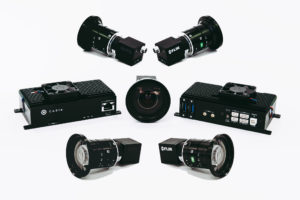 Iris Automation‘s latest product, the Casia 360, is a 360 degree onboard detect and avoid system – and a major step forward for flight beyond visual line of sight (BVLOS). The Casia 360 is a lightweight system that can be mounted on a drone. The system uses computer vision to “see” any other aircraft (or birds and other obstacles) in the air, safely making intelligent decisions about how to efficiently avoid them.
Iris Automation‘s latest product, the Casia 360, is a 360 degree onboard detect and avoid system – and a major step forward for flight beyond visual line of sight (BVLOS). The Casia 360 is a lightweight system that can be mounted on a drone. The system uses computer vision to “see” any other aircraft (or birds and other obstacles) in the air, safely making intelligent decisions about how to efficiently avoid them.
Putting detect and avoid systems onboard is a game changer for BVLOS flight. The Kansas Department of Transportation, using Iris Automation systems, has received a waiver for flight beyond visual line of sight without ground radar systems or visual observers: making linear infrastructure inspections scalable and inexpensive to perform by drone.
The following is a press release from Iris Automation.
Iris Automation announces Casia 360, the first onboard detect-and-avoid system for drones with 360-degree capability
 SAN FRANCISCO (April 6, 2020) — Iris Automation today announced the launch of Casia 360 – the first onboard detect-and-avoid (DAA) solution with a 360-degree radial field of view to enable commercial Beyond Visual Line of Sight (BVLOS) operations for Unmanned Aircraft Systems (UAS).
SAN FRANCISCO (April 6, 2020) — Iris Automation today announced the launch of Casia 360 – the first onboard detect-and-avoid (DAA) solution with a 360-degree radial field of view to enable commercial Beyond Visual Line of Sight (BVLOS) operations for Unmanned Aircraft Systems (UAS).
The Casia system allows an Unmanned Aircraft System to see and react to the aviation environment around the aircraft. Casia 360 detects other aircraft in all directions, uses computer-vision algorithms to classify them, makes intelligent decisions about the threat they may pose to the drone, then triggers an alert to the pilot in command and automated maneuvers to safely avoid collisions.
Casia is a combination of both hardware and software that is lightweight, low power and small in size. The low SWaP system is composed of two onboard controllers and five long-range optical cameras providing a 360-degree field of view. The software is packaged in a self-contained embedded supercomputer that works with the machine vision cameras onboard.
“Casia 360 allows a drone to have a complete sense of its surroundings so it can avoid potential collisions from any direction,” said Iris Automation CEO Alexander Harmsen. “We developed this technology based on feedback from our customers and regulatory bodies around the world. It enables drones to be used for an even greater range of long-distance use cases and saves money, increases safety and unlocks applications across multiple industries: railway, energy sector, utility powerline inspections, package delivery, and life-saving search and rescue operations.”
The Casia technology has been extensively tested, with real-world test flights and mid-air collision scenarios flying various manned aircraft against UAS, over 12,000 real-world encounters and more than 50,000 encounters in simulation. Casia is currently being flown by dozens of customers, across 12 countries and holds BVLOS approvals from regulators in the U.S., South Africa, and Canada.
Iris Automation is working directly with regulators around the world to make commercial drones safer and more accessible, ensuring Casia 360 achieves the highest levels of safety for national airspace use. Iris Automation also offers customers regulatory support for Part 107 waiver writing and regulatory approval processes to secure the necessary permissions for their unique UAS operations.
Casia 360 is available for commercial sales preorder now. The initial limited launch of the 360 system has sold out and this system is currently on back-order. For more information, and to secure your purchase, visit www.irisonboard.com/casia.
About Iris Automation
Iris Automation is building a computer-vision-based collision avoidance system that helps drones see the world how pilots do. The company is based in San Francisco and is led by a team with experience at NASA, Boeing, and Nvidia, including PhDs in computer vision. Iris is a key partner on multiple FAA UAS Integration Pilot Programs, a participant of NASA’s Unmanned Traffic Management program and a participant of Transport Canada’s BVLOS Technology Demonstration Program. Visit www.irisonboard.com

Miriam McNabb is the Editor-in-Chief of DRONELIFE and CEO of JobForDrones, a professional drone services marketplace, and a fascinated observer of the emerging drone industry and the regulatory environment for drones. Miriam has penned over 3,000 articles focused on the commercial drone space and is an international speaker and recognized figure in the industry. Miriam has a degree from the University of Chicago and over 20 years of experience in high tech sales and marketing for new technologies.
For drone industry consulting or writing, Email Miriam.
TWITTER:@spaldingbarker
Subscribe to DroneLife here.







[…] Automation, providers of the Casia onboard Detect and Avoid (DAA) collision avoidance system, has partnered with the City of Reno under the Federal Aviation […]